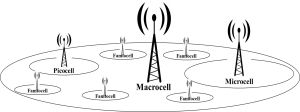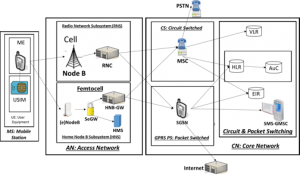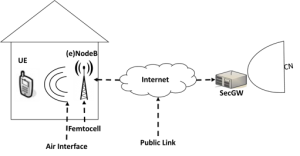
Overview on Mediation
Jul 17,2020
Abstract— Number of wireless network users are increasing day by day due to which the rate of data transfer and capacity of system also at increase. Approximately about four billion users are connected to wireless network thus reduces the efficiency and speed of network. If the transmitting and receiving devices in the wireless scenario are placed closer to each other, then this issue can be resolved. The distance between these devices can be reduced if the size of cell be reduced by cell splitting procedure. Cell size from macrocell to femtocell is the best solution as the distance among the devices is reduced from approximately 30 kms to 10 m. In other words, a macrocell is divided into number of femtocells. As the distance is too small therefore it is best suited for indoor places like residential/ industrial areas, academic institutions, buildings etc. Femtocell Access Points (FAP) are the base station (BS) which reduces the overall load of maintenance & infrastructure and moreover, provides a good Quality of Service (QoS). Internet is the base through which communication is established. Beside all these benefits, femtocell is surrounded with lot of challenges, interference is the worst one among all. The interference is anticipated between neighbouring femtocells and between femtocell and macrocell as well because both share same licensed frequency spectrum.
In this paper, number of challenges are discussed in general and interference in particular. Different interference types are elaborated and available solutions managing interference are also discussed. A proposed solution is suggested in the light of present scenario.
Keywords— Cellular network, internet, macrocell, femtocell, challenges, interference management
I. INTRODUCTION
The world has seen a revolutionary development in the field of telecommunication in last few decades which was not even think of in last few centuries. At present, telephone and internet are the necessities of life. People want to be connected at any time with anyone and at anywhere. The term anywhere was previously fulfilled with the help of wire which connect the people at long distances but have the drawback of being static. Later on the limitation of stationary is addressed by making wireless communication. Although mobility is achieved but there are places where there is no or poor signals. These places are unreachable due to depression, noise interference, etc. As the load of users increase day by day therefore issue of capacity and coverage is at rise. These problems are catered for by dividing the areas into smaller cells and adding more transceivers with less range.
There are different types of base stations (BS) used in the area which have different coverage ranges. The types are Macrocell, Microcell, Picocell, Femtocell and Umbrella cell. Macrocell being the original one covers the largest area and femtocell is the smallest BS covers the smallest. The major difference between these cells is that less femtocell all are deployed, monitored and maintained by the network operators. Femtocell is installed by the users at their office, home or building etc. femtocell is very useful at places where quality of poor signals can be improved and get full signals at the places of no signal areas. Performance of femtocell is effected by number of challenges like interferences, interception, location of equipment, QoS, etc. as explained in [1]. This paper is organized to highlight the merits and demerits of femtocell in general with special emphasis on the interference in particular. The available solutions will also be mentioned and the best among will be declared.
The paper is organized in sections. In section II, cellular network and femtocell with its benefits and drawbacks are described. In section III, challenges faced by femtocell are highlighted. In Section IV, types of interferences with their workable solution are discussed along with a proposed solution. In section V, the discussion will be concluded.
II. Cellular Networks and Femtocell
Cellular network can be defined as an area which has the shape of a honeycomb. The complete region, where coverage required, is part of this area. One hexagonal place in the honeycomb known as “cell” has an antenna erected at the designated place represents base station (BS). These cells create a cellular network where communication among the mobile station (MS) and mobile switching centre (MSC) is established through these BSs. The size of cells are determined keeping in view the implementation environment. The bigger cells cover more area and smaller cells cover less as shown in figure 1 below:-

Fig. 1 – Cells Coverage System
There are five different sizes of cells in the cellular network as in [2]. As this paper encompasses femtocell therefore other types will not be elaborated in detail. These types are depicted in figure 2 and explained as under:-
A. Types of Cells
1) Macrocell: The BS antenna is erected at the height of above a normal rooftop as its coverage ranges from 1 – 30 kms. These are installed, operated, managed and maintained by the operators of the network.
2) Microcell: The antenna height is below the rooftop and it ranges from 200m – 2 kms. It is best suited for urban areas and share macrocell load. These are installed, operated, managed and maintained by the operators of the network.
3) Picocell: These are small size cells used in large halls usually cover an area from 4 – 200 m. These are installed, operated, managed and maintained by the operators of the network.
4) Femtocell: These are very small cells covering from 1 – 10 m only. Best suited for the environment of residential and business setups. These are installed by the users and connected to the service provider through broadband internet.
5) Umbrella Cell: These are designed to cover those places among the smaller cells which are gaps or shadowed regions.

Fig. 2 – Types of Cells
B. Characteristics of Femtocell
The design of femtocell is based on its usage as it is to be installed in the home or office therefore it has got limited range. It is very different from other cellular networks because of three things. Firstly, users install the device themselves and not the cellular provider. Secondly, it provide communication through broadband of telephone line. Thirdly, users move from femtocell to macrocell seamlessly as explained in [3].
Femtocell devices are low capacity BSs which radiate the required power according to the area of home or office environment. Femtocells make connection to the network operator through the broadband which is available as a household. Once user leaves the femtocell premises then automatically connection is made through the cellular backhaul technique with macrocell BS as in [4]. There are number of benefits and drawbacks which are elaborated as under:-
1) Advantages: As described in [1, 5].
2) Disadvantages: As explained in [6].
C. Types of Femtocell
There is a wide range of technologies used in the manufacturing of femtocells. Likewise different services are available according to different types of femtocells. Figure 3 depicts the types and their details as under:-

Fig. 3 – Types of Femtocells
1) 2G Femtocells: These are the second generation based on GSM air interfaces having low cost and good quality voice. But could not get a success because the data transfer rate is very low as data services use General Packet Radio Service (GPRS) as in [7].
2) 3G Femtocells: These are based on Universal Mobile Telecommunication System (UMTS) air interfaces. The data rates are higher than 2G femtocells as in [8]. The connection is IP based with better allocation scheme for power management which is quite helpful in avoidance of interference with macrocell network. The manufacturers also developed a better version which is High Speed Packet Access (HPSA) as in [9].
3) OFDM Based Femtocells: Orthogonal frequency-division multiplexing (OFDM) is used as physical layer. Worldwide Interoperability for Microwave Access (WiMAX) and Long Term Evolution (LTE) femtocells are considered as an opening door to future technology. These provide higher data transfer rates with better services than their predecessors as in [10].
III. FEMTOCELL - CHALLENGES
Besides all benefits and likings femtocells do face number of challenges which require immediate attention. This paper has highlighted all of them and after critical analysis reached out to the foremost threatening challenge which is the “interference”. All the challenges with a viable solution are described in this section. Interference and its management being the main point of discussion will be elaborated in the next section. The details are as under:-
A. Network Architecture
Radio network controller (RNC) has the capability to handle about 10 – 100 BSs and addition of FAPs definitely increases the load. Figure 4 shows the relationship of components in femtocell architecture. The operator has to provide a scalable and secure interface to the femtocell over IP which should be cost effective also. Solution to this issue is proposed in the [11], the detail of proposal is as under:-
1) lu-b over IP: The RNC connects femtocells via lu-CS and lu-PS interfaces, circuit switch and packet switch respectively, which are already functional in the network of macrocell. The capital expenditure (capex) is low as RNCs are already available. This interface faces scalability and standardization problem.
2) Internet Media Sub-System (IMS)/ Session Initiation Protocol (SIP): A core network (CN) is placed between operator and femtocell by IMS and SIP interfaces. The user traffic is converted into IP packets by IMS and SIP does the voice over IP (VoIP) process. Now lu-b over problem is solved here which is scalability and standardization. The capex increases and operation expenditure (opex) also increases. Instead of one, two CNs are to be maintained, macrocell and femtocell require exclusive CNs.
3) Radio Access Network (RAN) Gateway: The RAN gateway has to be unlicensed mobile access (UMA) based. Operator and gateway is connected through the interfaces of lu-PS/CS.

Fig. 4 – Femtocell Architecture
B. Interferences
As femtocell and macrocell uses the same frequency range therefore interference is obvious. Since femtocells are deployed independently into a well-established cellular network so compatibility issue is there and both system has to interfere with each other. There are number of interferences types which have been identified by Femto – forum as mentioned in [12] are appended below:-
1) Femtocells and BSs (Macrocell) – Same Frequency: The network capacity will reduce once large number of femtocells are deployed within the premises of macrocell on the same frequency.
2) BSs (Macrocell) and Femtocells – Same Frequency: Here the situation and result will be same as above.
3) Inter-Femtocells: If there are lot of femtocells deployed in the area of a macrocell then during the operating mode a background noise is produced. This noise has an adverse effect on QoS of every femtocells.
4) Phone Signals Received by Macro and Femto Cells: There are chances where mobile phone connecting femtocell connects with surrounding macrocell as well due to the strong strength of signals. It create a noise for macrocell which hinders the functioning of macrocell network.
C. Femtocell – Limited Access
As the device can handle 4 – 6 users at one time so access has to be restricted to the authorized users only. This aspect creates the technical problems, when mobile devices forward request for connection and receive authentication failure then they try another authentication attempt. These attempts create a flood situation over the network which could create temporary blocking issue. This raises following issues which could be solved by deploying more femtocells in critical areas but not cost effective as described in [6]:-
1) Battery Drainage: Continuous authentication attempts drain the battery of mobile devices.
2) Network Load: Mobile devices may be connected to macrocell network thus increasing load over network.
3) Registration Rejection: Mobile devices may receive rejection of registration which results into no more searching of network on the same range of frequency.
There are three access modes which are currently in use as defined in [13]:-
1) Open Access: Open to all users.
2) Closed Access: Open to authorized users.
3) Hybrid Access: Only authorized users can access and visitors can be entertained on the request of owner.
D. Broadband Reliability
The backhaul connection which connect femtocell with the wireless carrier’s network, creates major technical problem. As these carriers create connection among macrocells and CNs by using backhaul connections therefore backhaul are considered as carrier grade. They provide a reliable connection with good QoS.
Whereas femtocells connect with the CN with the help of broadband via internet. Now internet does not promise any reliable connection or QoS. The users do not know the problem at the backhand and blame the femtocell for poor QoS or un-reliability of service as mentioned in [6].
An experiment was conducted in six countries of Europe by Epitiro, a renowned company for testing and providing solutions related to network and applications. Tests measured femtocells performance once used a backhaul over 4 – 6 internet service providers (ISPs). The performance varied with every ISP and no consistency observed in terms of voice call quality and loss of packet. Mean opinion score (MOS) was used to check the quality of voice as in [14].
E. Synchronization
There is a requirement of synchronization among femtocell base station and macrocell network. Femtocell need an accurate clock to meet the requirement. The reference clock regulate the reference frequency source. The vendors of femtocell do cater for this aspect in mind while manufacturing the femtocell devices.
The method of synchronization is well explained in [15] due to which femtocell is not in need of any discrete frequency conversions which macrocell is required.
F. Security and Performance
There are three vulnerable places where security breach could be expected. The breach has nothing to do with protocols or cryptosystem breaking. Keeping in view figure 5 below these three places namely air interface between mobile and femtocell devices, femtocell device and public link between security gateway and femtocell as described in [16]. Details of threats are as under:-

Fig. 5 – Femtocell – Security Breach
1) Air Interface: There could be chances of passive or active attack over the air interface. In passive, attackers only listen the conversation among the mobile and BS whereas in active, they listen, upload virus, or modify/ steal the data. Cryptographically has made difficult ground for active attacks but passive attacks are still a threat being non-observed. In the past, Global System for Mobile Communication (GSM) network made the user identifier system to cater for such issues but now all-IP and femtocell network has made it vulnerable. For security purpose GSM, Universal Mobile Telecommunication System (UMTS) or Long Term Evolution (LTE) are using Temporary Mobile Subscriber Identity (TMSI) which protect the mobile devices’ identity. Femtocell devices are still not much safe and possibility can’t be ruled out that malicious users could track any movement of the users. Once the movement is tracked then attack is imminent. One of the solution could be a protection mechanism should be devised for context-aware location privacy.
2) Femtocell: There is no difference either a mobile device is connected to macrocell BS (NodeB) or to femtocell BS [(e)NodeB], the reason is air interface uses the same protocol and standards of security. It would be easier for an attacker to launch an attack over femtocell network as it is a small and inexpensive equipment as compared to the rooftop located macrocell BS. The malicious users can be detected if they impersonate and show their far away location then femtocell has the ability to check them with trusted execution environments (TrE).
3) CN: The entry place of CN to the public internet is an exposed and vulnerable placed. It attracts internet based attacks like Denial of Service (DoS), distributed DOS (DDoS) or impersonation attacks. This happens as public IP addresses are exposed and femtocells require them for the smooth functioning of whole system. If common traits of such attacks are observed and noted then a security plan of defence mechanisms can be developed.
G. Self-Organizing Network (SON)
Femtocell network are different from other networks because customer or private organization install the devices at their own in an ad hoc manner. Here ad hoc means that there is no planning for radio frequency (RF) or site selection plan. Furthermore, non-involvement of operator in the deployment or maintenance of this network. Moreover, there are much more femtocell devices installed and deployed as compared to macrocells so physical deployment and maintenance is out of question.
Keeping in view of these aspects femtocells are designed in a way that they configure automatically and adapt the network at their own as well. This is known as plug-n-play operation or SON. The autonomous features include the automatic registration and femtocell authentication, discovering devices in the neighbours, auto synchronizing with all tiers, selecting the cell IDs and channels, optimizing the network and coverage, assigning of the frequencies, adjusting power, and managing all concerned operations etc. as explained in [17,18].
H. Cell Association and Biasing
As there are different sizes of cells are present in a mixed network therefore it is very challenging to assign BSs to the subscribers which are appropriate and accurate. Now each user faces a maximized Signal-to-interference-plus-noise ratio (SINR). Now reducing SINR means cell association to be looked into which leads to biasing. Here time and frequency both play an important role. Biasing has to be optimal which depends on following as in [17]:-
1) Throughput and QoS
2) The BSs and subscribers placing in the space
3) The patterns of traffic in the space-time
4) The mobile devices and BSs exploit the side information and adaptivity level.
I. Mobility and Soft Handover
As femtocell covers a small range of 10m so moving devices will be coming in and out of coverage area very frequently. In this case a continuous connectivity is very essential which is possible by seamless handovers procedure. These handovers are expected among femtocell to femtocell and femtocell to macrocell. The mobility is inbound and outbound respectively. In these scenarios there are number of challenges which require attention. The CN has defined proper procedures for mobility and handovers, may be vertical or horizontal as in [19] but femtocell has no well-defined procedure. As femtocell is not connected with CN directly rather via internet therefore a delay of connection is expected. This results in delay in handover signalling.
Code division multiple access (CDMA) femtocells also faces a problem of not sharing a radio network controller (RNC) with a macrocells network or femtocell network for the coordination of soft handovers. The suggested solution to address this problem is to have some architecture modifications in CN and functions of femtocell gateway as in [10].
IV. INTERFERENCE MANAGEMENT
The mobile devices which operate in two environment, indoor and outdoor, faces two different network BSs or tiers; macrocell and femtocell networks. The femtocell architecture has to cater for both layers. The new two tiers architecture enjoys QoS, coverage and capacity and these tiers are the co-tier and cross-tier infrastructure. Any new adventure or invention has its inbuilt weaknesses so femtocell architecture do face such issues and the worst one is interference and its management among other challenges. Types of interferences in co-tier and cross tier have already been described in section III of this paper. Now in this section their management is discussed in detail.
There are a number of techniques as explained in [20] to manage the co-tier and cross-tier interference in femtocell network environment, figure 6 shows the available interference management schemes along with a proposed solution. Their details are as under:-

Fig. 6 – Interference Management Techniques
A. By Cancelling
By using these schemes receiver get the reduced rates of interferences. Once receiver is in receipt of such interferences these schemes cancel them at once. In this technique the required information is demodulated/ decoded. The decoded information is used with the channel estimates to cancel the interference as in [21]. Schemes are as under:-
1) SIC: All users are handled one by one, it means SIC carry on detection for a single user per stage. The detection is done keeping in view the strength of signals. Whichever is strongest will be catered for first and then second level strongest signal and so on.
2) PIC: All the users are detected simultaneously. The initial estimates are kept and used in near future for interference cancellation. Same way a parallel detection is carried out repeatedly to all stages.
3) MSIC: Once PIC is used over all stages then it is called multistage level interference cancellation.
4) MUD: It is best for CDMA system, where every user has its spreading code. It identifies each user’s signature and select the most likely signal. It carries out a multiple detection which gives out benefits to all CDMA users.
B. By Avoiding
As the deployment of femtocells are of ad hoc nature therefore they are not manageable and controlled by some central unit so there is a need for FAPs to intelligently handle and manage the situations. FAPs are to be self-organized and tackle with interference independently. Since every femtocell is located at different place facing different challenge so there schemes to handle interference is also different accordingly. These schemes are meant for avoiding the interference. The details of these schemes are as under:-
1) Spectrum Splitting: If the spectrum is divided into two parts, one each for macrocell and femtocell users’ then only femtocell to femtocell interference can be taken care off and moreover it reduces the efficiency as well [22].
2) Power Control: The performance can be increased by controlling and optimizing the femtocells transmitted power, it further give protection to users’ equipment in the macrocell. But this scheme is time consuming and complex in nature as in [23]. There is another technique where femtocells are provided with the power control and once FAPs observe that macrocell user faces interference they simply reduce the transmission power as in [24].
3) Time Hopping: This is a scheme for CDMA where femtocell to macrocell interference is reduced. It can be described as division of transmission is done into small pieces/ portions. Transmission is carried out by the users in one of the portions and during other portions they remain silent. Both networks can choose their period of transmission independently if synchronization is not there between the both. The scheme resulted into a success as reduction of interference is observed between femtocell to femtocell and femtocell to macrocell network interference as in [25].
On the other hand Orthogonal Frequency-Division Multiple Access (OFDMA) is quite flexible in such scheme’s designing. OFDMA seek knowledge about surroundings due to which FAP could perform allocation of sub-channels efficiently. A dedicated spectrum is divided into two portions, one each for macrocell and femtocell operations as in [26].
4) Spectrum Arrangement Schemes: This scheme is meant for cross-tier interference avoidance. Spectrum is sub-divided in two parts, one covers the macrocell area and other covers the macrocell-femtocell shared area. Mobile operators configure with the femtocell [(e)NodeB] spectrum frequency. The macrocell BS (NodeB) has the knowledge of (e)NodeB allocation of frequency. Basing on this information an interference pool is developed by NodeB where macrocell users equipment (UEs) would be a threat to closely placed (e)NodeB. To reduce the threat these UEs are dedicated a portion of spectrum from the macrocell allocation which results into cross-tier and co-tier interference reduction as in [27].
C. By Distributed Management
Since femtocells work in isolation therefore fighting with interference is very difficult. Knowledge about deployed femtocells in surrounding can be shared among femtocells through backhaul but it would create congestion on the network. The solution to this problem is the distributed schemes for interference avoidance. There are number of algorithms mentioned in [20] where distributed power control manages the interference.
D. Proposed Solution
The cell size plays an important role in the increase or reduction of interference among the co-tier or cross-tier infrastructure. Once the cell is divided into small areas like macrocells are divided into femtocells then the moving devices creates an environment where handoffs are frequent. But the benefits of reduced power consumption is an added advantage due to the reduction of cell size.
In the proposed scheme if the spectrum is split into four parts which should be unequal. The inequality is because of the area distribution, as the macrocells cover more area then femtocells therefore more spectrum allocation would be with macrocells. The allocation of frequency will use the reuse factor from 1 to 4. The allocation of frequency and reuse factor will also be used by the femtocells in accordance with macrocells. By this mean a seamless handoff will be achieved and interference will also be eliminated very effectively.
V. CONCLUSION
This paper has been organized in order to highlight the cellular concepts in wireless environment where users face a hurdle in terms of interference among the same co-channel and adjacent channels. In today’s world technology has come to that extent where pervasive computing and cloud computing has revolutionized the entire world. Everyone wants to be connected all the time to everyone and at all the places. Although Macrocell, Microcell, Picocell and umbrella cell has made it possible to connect everyone, but there are places like indoors where femtocells are the solution. There are two prominent benefits of installing femtocell and these are interference is considerably reduced whether it is co-tier or cross-tier, secondly signal strength also increases to full.
In a nutshell, this paper encompasses advantages and disadvantages of femtocell in general and interference along with its types and solutions in particular. A proposed solution has also been highlighted in the light of available solutions.
References
[1] Femtocell website. [Online}. Available:
[2] A. Kumar and V. Verma, “Study on Improving Coverage Area by Cell Splitting and Cell Sectoring Method in Cellular System”, IJARCSSE, vol 4, India, 2014, pp. 813-814
[3] G. Fanti and K. Lee, “Femtocell Networks”, 2010, pp. 1.
[4] Darrell Davies, “Femtocells in the Home”, Motorola briefing papers, Dec 2007, pp. 4-5.
[5] “Femtocells - Benefits, Challenges and Deployment Scenarios”, Cellular Asset Mgmt ltd, 2010, pp. 5.
[6] Nadia Qasim et. al. “Femtocell - A Vehicle to Mobile Communications”, Proc. 11th Intl Conf. on Stat. Sci. Pakistan, 2013, pp. 30-32.
[7] S. S. Prasad and R. Baruah, “Femtocell mass deployment: Indian perspective”, 3rd Intl. conf. on anti-counterfeiting, Sec. and Ident. Comm. Aug. 2009, pp. 34–37.
[8] M. Neruda et. al. “Femtocells in 3G mobile networks,” 16th Intl. Conf. on Sys. Sig. and Image Processing, Jun. 2009, pp.1–4.
[9] M. Yavuz et. al. “Interference management and performance analysis of umts/hspa+ femtocells,” IEEE Comm. Mag., vol.47, no.9, Sep. 2009, pp. 102–109.
[10] L. Wang et. al. “Mobility management schemes at radio network layer for LTE femtocells,” IEEE 69th Veh. Tech. conf. Spain, Apr. 2009, pp.1–5.
[11] V. Chandrasekhar and J. G. Andrews, “Femtocell Networks: A Survey”, Uni of Texas, USA, 2008, pp. 11-12.
[12] K. Elleithy and V. Rao, “Femto Cells: Current Status and Future Directions”, IJNGN, vol.3, Mar. 2011, Uni. of Bridgeport, USA, pp. 6-7.
[13] D. Choi, P. Monajemi, S. Kang, and J. Villasenor, “Dealing with loud neighbours: The beneï¬Âts and tradeoffs of adaptive femtocell access,” IEEE Global Telecommunications Conference,pp.1–5,Nov.30-Dec. 42008.
[14] “Femtocell voice quality and the critically important backhaul” Femto-Forum. [Online] Feb. 16, 2009. Cited: March 12, 2010.
[15] T. Cameron and P. Forbes, “Analog Front End for 3G Femto Base Stations Brings Wireless Connectivity Home”, Analog Dialogue 42-12, Dec. 2010, pp. 3-4.
[16] I. Bilogrevic et. al. “Security Issues in Next Generation Mobile Networks: LTE and Femtocells”, LCAI, Switzerland, 2010, pp. 1-3.
[17] J.G. Andrews et. al. “Femtocells: Past, Present, and Future”, IEEE Journal on sel. Areas of comm. vol. 30, no. 3, Apr. 2012, pp. 502-503.
[18] S. Yeh et. al. “WiMAX Femtocells: A Perspective on Network Architecture, Capacity, and Coverage”, IEEE Comm. Mag. vol. 46, Oct. 2008, pp. 58-65.
[19] R. Kumar and B. Singh, “Comparison of Vertical Handover Mechanisms using generic QoS Trigger for next Generation Network” IJNGN, vol. 2, No. 3, Sep. 2010, pp. 80-97.
[20] T. Zahir et. al. “Interference Management in Femtocells”, uni. of Surrey, UK, Jul. 2010, pp.
[21] J. G. Andrews, “Interference cancellation for cellular systems: A contemporary overview,” IEEE Wireless Comm. vol.2, no.3, Apr. 2005 USA, pp. 19–29.
[22] R. S. Karlsson, “Radio resource sharing and capacity of some multiple access methods in hierarchical cell structures,” in Vehicular Technology Conference, vol. 5, pp. 2825–2829,Sep.1999.
[23] K. Han, Y. Choi, D. Kim, M. Na, S. Choi, and K. Han, “Optimization of femtocell network conï¬Âguration under interference constraints,” 7th International Symposium on Modeling and Optimization in Mobile, Ad Hoc, and Wireless Networks,pp.1–7,23-27Jun.2009.
[24] T. Zahir, K. Arshad, Y. Ko, and K. Moessner, “A downlink powercontrol scheme for interference avoidance in femtocells,” 7th International Wireless Communications and Mobile Computing Conference (IWCMC), 2011,pp.1222–1226,4-8July2011.
[25] A. K. Elhakeem, R. D. Girolamo, I. B. Bdira, and M. Talla, “Delay and throughput characteristics of TH-CDMA, TDMA, and hybrid networks for multipath faded data transmission channels,” IEEE J. Se. Areas Commun.,vol.12,no.4,pp.622–637,May1994.
[26] D. Lopez-Perez, A. Juttner, and J. Zhang, “Optimisation methods for dynamic frequency planning in ofdma networks,” Networks , Budapest, Hungary,Sept.2008.
[27] N. Saquib et. al. “Interference Management in OFDMA Femtocell Networks: Issues and Approaches” IEEE Wireless Comm. Jun. 2012, Pp. 88-89.
Filed Under: Cellular Network Macrocell Femtocell Internet Interference Management Challenges




 More +
Select My Tutor virality graph
More +
Select My Tutor virality graph| User Type: | Tutor Verified |
| Name: | Rana |
| Uploaded Date: | Feb 17,2016 |
Computer Science and IT subjects expert who can guide, assist and monitor the struggling students in the field of pervasive computing, computation, Networking etc.